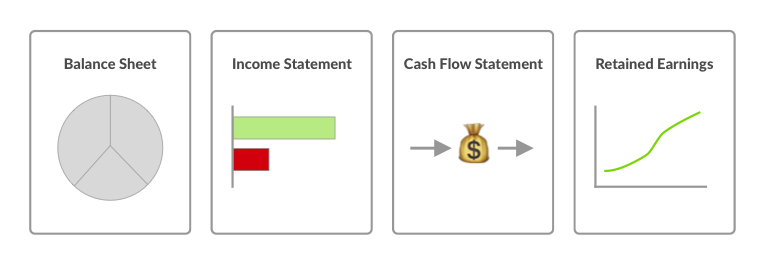The Four Basic Financial Statements
A confirmation email has been sent to your email.

Analysis of the four basic financial statements gives you an idea of your overall financial health, and for that reason alone it’s important to understand them.
But the real reason to dig into your financial statements is that they are brimming with valuable information from a financial management perspective. If you want to raise money, develop a new product, open a new office, or take any other action to grow your business, you’ll rely on the financial statements as guides to what is possible.
In this post, we’ll cover what the four basic financial statements are and how they can help your company plan for the future.

The four basic financial statements (and why they matter)
The four basic financial statements are the income statement, balance sheet, statement of cash flows, and statement of retained earnings.
Your financial statements are dynamic reports full of insights just waiting to be extracted and used to achieve your business objectives. A solid understanding of each statement allows you to be proactive instead of reactive.
Balance sheet
The balance sheet shows a company’s assets (what you own), liabilities (what you owe), and equity (the difference between your assets and liabilities). It’s essentially an account of how efficiently you are putting your business resources to work.
Your balance sheet and financial planning
The balance sheet provides a snapshot of your financial position at one moment in time, and allows you to figure out your solvency vs. liquidity ratios, which are important for managing debt.
The balance sheet also helps you understand whether you can acquire capital, distribute dividends, or even just pay your bills.
A thorough understanding of your balance sheet allows for better budgeting, which is a crucial and underrated aspect of financial management. With an accurate budget, a business can plan operations, coordinate activities, and better communicate high-level plans to various managers.
Income statement
Also commonly known as a profit and loss (P&L) statement, your income statement shows revenues, expenses, and profit/loss over a given period of time. At its core, it tracks how your business’ net revenue is translated into earnings.
You can think of the relationship between the income statement and balance sheet in terms of getting tests at the doctor’s office.
Your balance sheet shows data points for just one moment in time. That’s like a one-time blood test saying your cholesterol was 250 on April 30th, 2019. Your income statement tracks changes. That’s like multiple blood tests showing that your cholesterol has gone up 15% per month over the last six months (and your doctor might tell you to cut back on the burgers).
Your income statement and financial planning
By analyzing your income statement, you can pinpoint what aspects of your operation are correlated with high-growth periods and what aspects lead to stagnation. This can help you determine which aspects of your business should receive more money, and which are in need of support. Income statement analysis of this kind can also help with forecasting and assessing risk, as it gives you a clear idea of how certain initiatives translate into earnings.
Investors and lenders will also want to know if you are profitable, and when you expect to be, if ever. The income statement helps tell them that.
Finally, don’t confuse a good business with one that shows high profits. As Uber’s recent IPO and high valuation prove, you can still have a solid business even while posting operating losses in the billions of dollars per year. Sometimes, it’s revenue that matters most to investors.
Statement of cash flows
The statement of cash flows is a summary of the cash moving in and out of your business. While similar to the income statement, there is a key difference — the income statement is hypothetical. Meaning, for companies that use accrual accounting, the revenue the income statement lists might not have been paid yet.
Your statement of cash flows and financial planning
An understanding of this statement helps you determine how much cash you can devote to growing your business, and whether you have a sustainable cash outflow. While there are a million and one financial tricks you can play to keep a business running, cash is still king and must be accounted for.
If you see a large discrepancy between your revenues and your cash flow, you can take action. That could mean changing up how you invest, switching vendors, or reassessing how you extend credit.
The statement of cash flows also helps potential investors determine the financial viability of your business. Do you have a history of successfully predicting and covering expenses? How long does it take to pay your suppliers? Questions of this type help investors figure out the stability of your operation.
Statement of retained earnings
The statement of retained earnings tracks the changes in equity over a given period. Your retained earnings are equal to the amount of net income left over once you’ve paid out dividends to stockholders. Thus, it shows whether your business profits went up or down over the period.
Your statement of retained earnings and financial planning
The statement of retained earnings is not usually as rigorously tracked as the previous three statements. But it always needs to be prepared when a business is fundraising. Investors need an accurate picture of what you are doing with your profits. They also need to know what activities you are undertaking to generate high returns to shareholders.
It’s also an important statement lenders use when determining whether you can borrow money. If, for example, your profits are on a consistent downward trend, it could be a red flag for lenders. If you are hoping to get financing for a future project, you can use the statement of retained earnings in conjunction with the other financial statements to find profit-generating aspects of your business to support.
The future belongs to the agile
The business environment is changing faster than ever. The average age of a company in the S&P 500 is under 20 years, down from 60 in the 1950s. And it’s falling quickly.
The successful modern companies are the ones that stay nimble. They also plan strategically, and incorporate cutting-edge technology. Analyzing and strategizing based on the four basic financial statements will help your firm do just that.
For example, you can use the statements to figure out your debt to equity ratio. If it’s quite high, you might decide to pay down debt before going through with a high-risk acquisition.
Planning for success with Pilot
Despite the importance of clean and up-to-date financials, most business owners are understandably more passionate about sales and marketing than they are about the intricacies of bookkeeping. That’s where Pilot comes in.
Our team will take the bookkeeping off your hands so that you can focus on higher level tasks that drive growth and keep you competitive.


